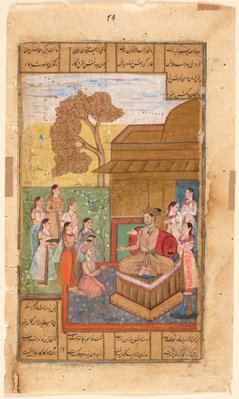-
Details
- Other Title
- Story of Bahram Gur
- Place where the work was made
-
Golconda
→
Hyderabad
→
Telangana
→
India
- Period
- Deccani Mughal circa 1590 - circa 1800 → India
- Date
- late 17th century
- Media category
- Painting
- Materials used
- opaque watercolour on paper
- Dimensions
- 20.7 x 12.1 cm image; 25.2 x 15.0 cm sheet
- Credit
- Gift of Dr Jim Masselos 2022
- Location
- Not on display
- Accession number
- 55.2022
- Copyright
- Share
-
-
About
While originating in what is now Iran, the traditions of Persian poetry and story-telling through text and illuminations held a great sphere of influence over neighbouring empires. Patrons of the Ottoman Turks and the Indian Mughals commissioned poets and artisans to retell the dramatic episodes of love in the courts and bloodshed on the battlefields. A number illuminate the Persian epics that celebrate love and heroism such as the Shahnameh (Book of Kings) completed by Abu’l Qasim Firdausi in 1010 CE and the Haft Pakyar (The Seven Beauties) written by Nizami Ganjavi in 1197. While the works remain secular they are laden with moralistic and legendry tales laced with historical figures and events. A hero of both epics is Bahram Gur whose character derives from the historical Sasanian king, Bahram V. Here we see Bahram Gur as mentioned in Amīr Khusrau’s poem Hasht-Bihisht (The Eight Paradises) written circa 1302 and based on Nazmi’s Haft Paykar.
-
Bibliography
Referenced in 1 publication
-
Sotheby's London, Fine Oriental Manuscripts and Miniatures including Property from the Estate of King Umberto II of Italy, London, Oct 1984. lot 35
-

